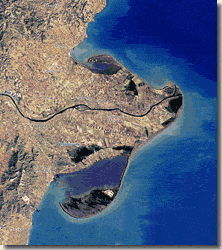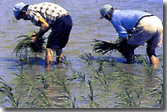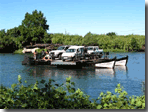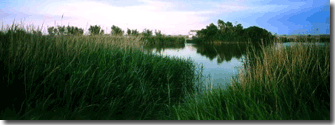|
 |
NATURAL PARK RIVER
EBRO DELTA |
320 square kilometres that form the Nature reserve of the Ebro Delta constitutes one of the largest humid area of the Mediterranean Europe. In this protected area we can contemplate gardens, fruit-bearing trees and rice fields, and if we wait until the right time of year to visit, you will be able to observe the delightful sight of migrating and nesting birds. Visitors to the Delta should not be in the hurry; a bicycle ride permits you to admire the singularity of the place and to enjoy the nature up close. The park is provided with several areas of information where you will be able to obtain information on the fauna and the flora, and some rules and advice so as not to put in danger the conservation of the area.
|
| CLICK ON THE PHOTO FOR A GALLERY OF THE AREA |
|
 |
In the right hand side of the Delta you can find Sant Jaume D´Enveja communicated with the population of Deltebre by means of two small ferries. Els Muntells, La Tancada and the long beach of the Trabucador, the Poble nou of the Delta is next to the natural reserve of L´Encanyssada |
 |
|
In the left hand side of the Delta you can find Marquesa beach and the lighthouse of Fangar and it's beach along with the beach of Riumar. To cross to the another side of the river you can use the ferries. There are various towns and villages in this area. L'Aldea, Camarles and Deltebre -la Cava are perhaps the most important. Only one kilometre of L'Aldea you can visit the Chapel of the
de la Virgen de los Prats . |
The Nature reserve of the Delta de l'Ebre includes a completely horizontal space that combines the use for rice fields, vegetation areas, the lagoons and ponds and, also, long beaches of fine sand. It is a peninsula that penetrates into the sea about 30 kilo meter, with a triangular form that the river has been creating with the materials that it drags along in it's path. It's ecosystem is vitality importance for the balance of the fauna and together with the mouth of the river Rhone, in the French Camarga, and the National Park of Doñana, the mouth of the Guadalquivir makes it important for conservation of the nature. It's vital value takes root in the fact that there it shelters an important colony of resident and migratory birds. The protection dates to the year 1983, extended in 1986 and goes so far as protecting a quarter of the |
 |
whole of the delta, essentially the least populated area: La Punta del Fangar, to the north, La Punta del Banya, on the south, and the island of Buda, in the mouth of the river, as well as the zones of lagoons and salt marshes of the Canal Vell |
La Tancada and L'Encanyissada, especially. Next to the latter in the natural reserve you can fins an information point , known as the Casa de Fusta that, along with the information point in the town of Deltebre, are the starting points for getting to know this wonderful world. The delta shows a harmonious combination between a scenery humanized (from the installation of rice fields and breeding grounds of shellfish at the end of the XIXth century) and the natural scenery of reed beds, vegetation and sandbanks. It's beauty and colour change according to the time of year: an intensely green scenery between spring and summer crystalline in autumn and blue in the winter |
| In many places we will find bird observatories that you could previously only enjoy from watching documentaries. Here in the Delta this turns into. On the pretext of admiring them you will be able to at least savour, a relaxed evening , when the sun starts to set. |
|
|
|
|
|
| |
|
|
|
|